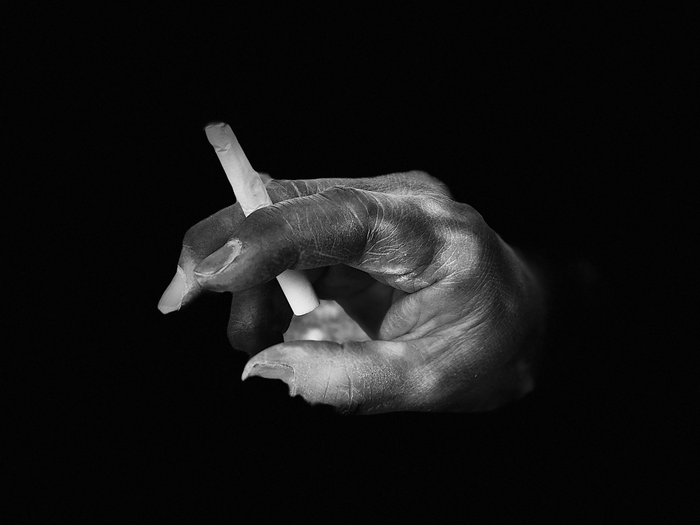RIVERSIDE, Calif. — Thirdhand smoke, or THS, comprises the residual pollutants from tobacco smoke that remain on surfaces and in dust after tobacco has been smoked. It can remain on indoor surfaces indefinitely, causing potentially harmful exposure to both smokers and non-smokers.

Credit: Celeste Lum.
RIVERSIDE, Calif. — Thirdhand smoke, or THS, comprises the residual pollutants from tobacco smoke that remain on surfaces and in dust after tobacco has been smoked. It can remain on indoor surfaces indefinitely, causing potentially harmful exposure to both smokers and non-smokers.
A team led by researchers at the University of California, Riverside, has found that acute exposure of the skin to THS elevates biomarkers associated with the initiation of skin diseases, such as contact dermatitis and psoriasis.
“We found exposure of human skin to THS initiates mechanisms of inflammatory skin disease, and elevates urinary biomarkers of oxidative harm, which could lead to other diseases, such as cancer, heart disease, and atherosclerosis,” said Shane Sakamaki-Ching, a former graduate student at UC Riverside who graduated with a doctoral degree in cell, molecular, and developmental biology in March 2022. “Alarmingly, acute dermal exposure to THS mimics the harmful effects of cigarette smoking.”
The study, published in eBioMedicine of The Lancet family of journals, is the first to be performed on humans exposed dermally to THS.
The clinical investigation, which took place at UC San Francisco, involved the participation of 10 healthy, non-smokers who were 22 to 45 years old. For three hours, each participant wore clothing impregnated with THS and either walked or ran on a treadmill for at least 15 minutes each hour to induce perspiration and increase uptake of THS through the skin. The participants did not know the clothing had THS. Blood and urine samples were then collected from the participants at regular intervals to identify protein changes and markers of oxidative stress induced by the THS. Control exposure participants wore clean clothing.
“We found acute THS exposure caused elevation of urinary biomarkers of oxidative damage to DNA, lipids, and proteins, and these biomarkers remained high after the exposure stopped,” said Sakamaki-Ching, now a research scientist at Kite Pharma in California, where he leads a stem cell team. “Cigarette smokers show the same elevation in these biomarkers. Our findings can help physicians in diagnosing patients exposed to THS and help develop regulatory policies dealing with remediation of indoor environments contaminated with THS.”
Prue Talbot, a professor of cell biology in whose lab Sakamaki-Ching worked, explained that skin is the largest organ to contact THS and may thus receive the greatest exposure.
“There is a general lack of knowledge of human health responses to THS exposure,” said Talbot, the paper’s corresponding author. “If you buy a used car previously owned by a smoker, you are putting yourself at some health risk. If you go to a casino that allows smoking, you are exposing your skin to THS. The same applies to staying in a hotel room that was previously occupied by a smoker.”
The THS exposures that the 10 participants were subjected to were relatively brief and did not cause visible changes in the skin. Nevertheless, the molecular biomarkers in blood that are associated with early-stage activation of contact dermatitis, psoriasis and other skin conditions were elevated.
“This underscores the idea that dermal exposure to THS could lead to molecular initiation of inflammation-induced skin diseases,” Sakamaki-Ching said.
Next, the researchers plan to evaluate residues left by electronic cigarettes that can come into contact with human skin. They also plan to evaluate larger populations exposed to longer periods of dermal THS.
Sakamaki-Ching and Talbot were joined in the study by Jun Li of UCR, Suzaynn Schick of UC San Francisco, and Gabriela Grigorean of UC Davis.
The study was supported by grants to Talbot and Schick from the Tobacco Related Disease Research Program of California.
The title of the research paper is “Dermal thirdhand smoke exposure induces oxidative damage, initiates skin inflammatory markers, and adversely alters the human plasma proteome.”
The University of California, Riverside is a doctoral research university, a living laboratory for groundbreaking exploration of issues critical to Inland Southern California, the state and communities around the world. Reflecting California’s diverse culture, UCR’s enrollment is more than 26,000 students. The campus opened a medical school in 2013 and has reached the heart of the Coachella Valley by way of the UCR Palm Desert Center. The campus has an annual impact of more than $2.7 billion on the U.S. economy. To learn more, visit www.ucr.edu.
Journal
EBioMedicine
DOI
10.1016/j.ebiom.2022.104256
Method of Research
Experimental study
Subject of Research
People
Article Title
Dermal thirdhand smoke exposure induces oxidative damage, initiates skin inflammatory markers, and adversely alters the human plasma proteome
Article Publication Date
19-Sep-2022
COI Statement
The authors did not receive direct funding for this project. Funding from TRDRP was administered via the institution. All authors declare no direct support from any organization for the submitted work, no financial relationships with any organizations that might have an interest in the submitted work in the previous three years, and no other relationships or activities that could appear to have influenced the submitted work.




